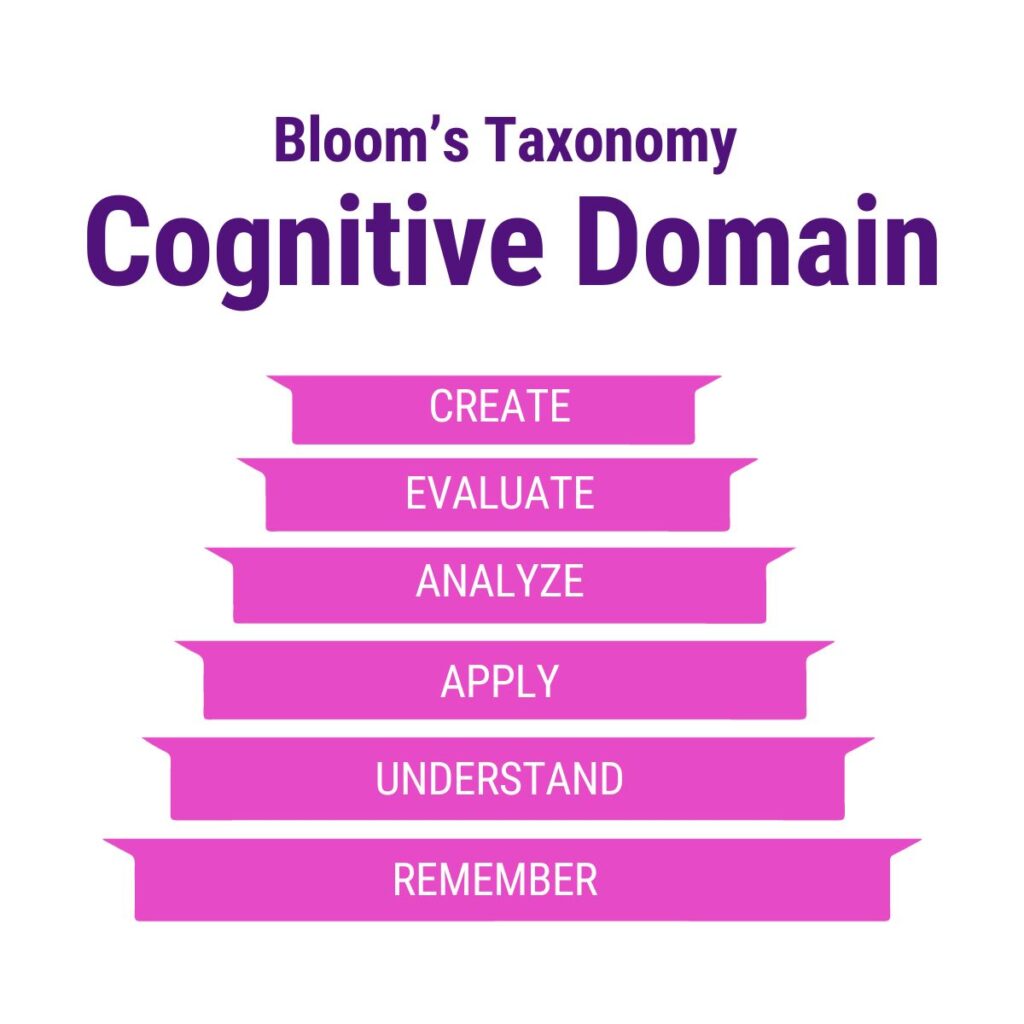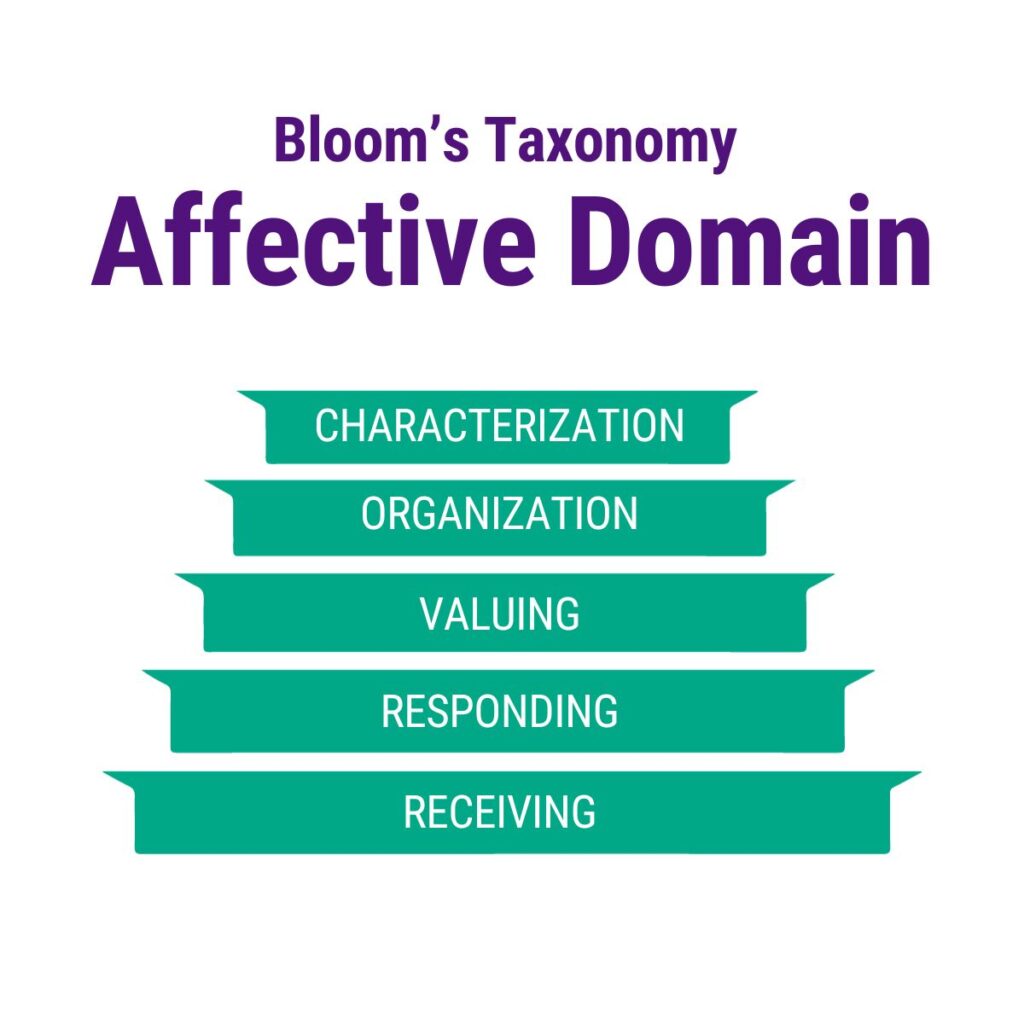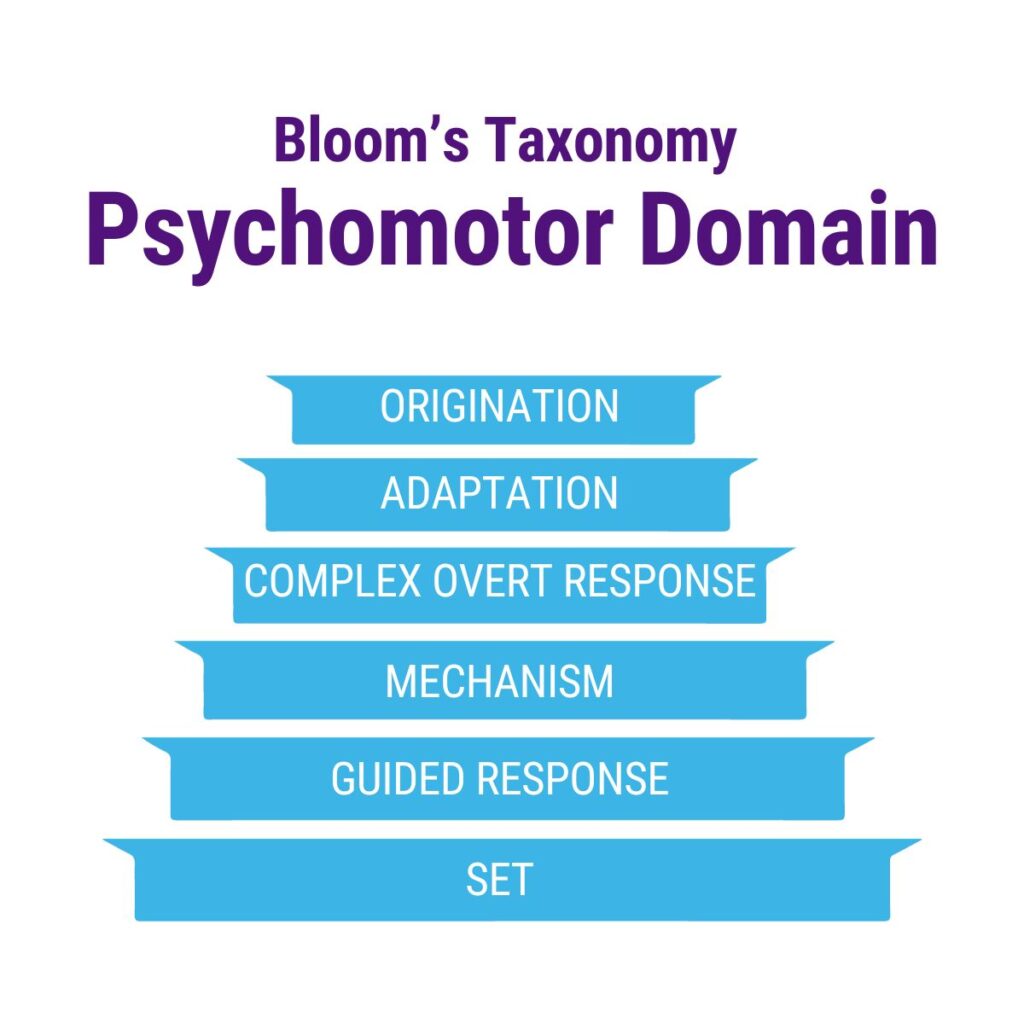When creating courses for a learning and development program, following scientifically proven industry best practices for knowledge retention increases the chances of success. One well-known approach is to break the material down into steps and slowly add information as each level is reached. In 1956, an educational psychiatrist named Benjamin Bloom created a system that he called Bloom’s taxonomy.
In this blog, we will review what this system is and why it remains relevant today for anyone creating training courses.
Key takeaways
Bloom’s taxonomy helps structure learning outcomes – Bloom’s six-level framework (remember, understand, apply, analyze, evaluate, create) offers a clear structure for building learning programs that progress from basic knowledge to higher-order thinking and problem-solving.
Clear action verbs make learning objectives measurable – Using specific verbs like define, demonstrate, or design ensures that learning objectives are clear, targeted, and easy to assess—avoiding vague goals like “understand the topic.”
Most training only targets lower-level thinking – Many workplace training programs stay at the “remember” or “understand” levels. To build true capability, organizations should design learning experiences that progress from application to analysis and creation.
Bloom’s taxonomy aligns training with business goals – When learning objectives match the level of thinking required for a job, learners are more likely to transfer knowledge into meaningful workplace performance.
Use Bloom’s to identify and fix gaps in your programs – Evaluating existing courses using Bloom’s taxonomy can reveal where learning is too shallow or lacks progression.
Modern tools like LEAi automate the objective-building process – AI-powered tools such as LearnExperts’ LEAi streamline the process of writing Bloom-aligned learning objectives, making it easier to scale high-quality training across an organization.
What is Bloom’s taxonomy?
Bloom’s taxonomy is a set of three hierarchical models used for classification of educational learning objectives. Basically, it helps instructors teach and students learn.
Originally, Bloom’s taxonomy was one-dimensional with an exclusive focus on the knowledge domain. Anderson and Krathwohl created a new version of the hierarchy that used verbs, instead of nouns. The idea was that the original hierarchy was not focused on the acquisition of abilities, but the usage and application of them.
Changing each level’s description to verbs better describes the action of preforming at that level, and makes the hierarchy easier to understand. Although the words have changed, the idea of the hierarchy remains the same.
What is Bloom’s used for?
Bloom’s taxonomy is a valuable tool in course creation, guiding learners from the foundational stages of recall and comprehension to evaluation and innovation. This framework also helps in the design of assessments by aligning them with the desired level of proficiency based on the learning objectives. Specifically, Bloom’s taxonomy is used for:
- Curriculum Development: Structuring the content and skills learners need to master. For example, in basic, introductory courses, the emphasis might be on assessing the fundamental layers of the taxonomy. In advanced, higher-level courses, the focus will shift to evaluating learners’ competencies.
- Lesson Planning: Ensuring that lessons cover a range of cognitive skills. For example, a lesson might start with recall questions and progress to tasks requiring evaluation or creation.
- Assessment Design: Categorizing test and assignment questions on the level of the required cognitive skills.
- Instructional Objectives: Setting clear and measurable objectives for what learners should know and be able to do by the end of a course, lesson or module.
- Encouraging Higher-Order Thinking: Ensuring that the training includes more tasks that require analysis, synthesis, and evaluation.
Domains in Bloom’s taxonomy
Within Bloom’s Taxonomy there are three categories or domains of learning:
- Cognitive domain: The cognitive domain includes intellectual abilities, such as knowledge retention and application, recognizing patterns, understanding concepts and solving problems.
- Affective domain: The affective domain involves feelings and emotions, and learners placing value or developing appreciation for subjects or goals. It also involves learners understanding their own values and how the course being taken relates to them.
- Psychomotor domain: The psychomotor domain includes all of the physical skills that are learned, like reflexes, coordination and fine motor control. It also includes any type of physical movement, like certain motions or physical activities.
Within each of the three domains, there are learning levels. The idea behind the levels is that each level is “higher” than the previous one, so a way to teach effectively would be to teach the lower levels first and then move to the higher ones. Using Bloom’s taxonomy allows learners to reach a deeper understanding of whatever it is that they are learning by first building up basic skills and then moving onto more complex ones.
Bloom’s taxonomy with verbs for cognitive domain
Within the cognitive domain there are six distinct levels of thinking in a hierarchy, with each level being more difficult than the last. These levels are Remember, Understand, Apply, Analyze, Evaluate and Create

Remembering: recalling or repeating facts, information, ideas and concepts.
Verbs: recall, recognize, write, tell, identify, find
Cue Questions: What is the…? How is …? Where is …? When did _______ happen? How did ______ happen? How would you explain …? How would you describe …? What do you recall …? How would you show …? Who (what) were the main …? What are three …? What is the definition of…? Identify the correct answer of…
Understanding: explaining ideas or information that have already been learned.
Verbs: define, describe, interpret, summarize, explain, discuss
Cue Questions: Summarize the idea of… How would you explain the process of…? Describe the meaning of the results of…How would you classify the type of …? How would you compare …? contrast …? How would you rephrase the meaning …? What facts or ideas show …? What is the main idea of …? Which statements support …? How can you explain what is meant …? What can you say about …? Which is the best answer …? How would you summarize …?
Applying: using information learned in a new context or situation.
Verbs: apply, solve, calculate, demonstrate, examine, use, implement
Cue Questions: How would you solve…? Examine the results of…? Use the data to demonstrate that… How would you use …? What examples can you find to …? How would you solve _______ using what you have learned …? How would you organize _______ to show …? How would you show your understanding of …? What approach would you use to …? How would you apply what you learned to develop…? What other way would you plan to …? What would result if …? How can you make use of the facts to …? What elements would you choose to change …? What facts would you select to show …? What questions would you ask in an interview with…?
Analyzing: drawing connections and understanding smaller parts of a whole.
Verbs: analyze, compare, distinguish, categorize, classify, investigate
Cue Questions: Analyze the results of… What would you use to categorize the…? How would you compare multiple different…? What are the parts or features of …? How is _______ related to …? Why do you think …? What is the theme …? What motive is there …? What conclusions can you draw …? How would you classify …? How can you identify the different parts …? What evidence can you find …? What is the relationship between …? How can you make a distinction between …? What is the function of …? What ideas justify …?
Evaluating: judging decisions based on what was learned.
Verbs: evaluate, asses, judge, determine, defend, verify, support, debate
Cue Questions: What criteria could be used to evaluate…? Defend your stance on… How would you judge the…? Why do you agree with the actions? The outcomes? What is your opinion of …? (Must explain why) How would you prove …? disprove …? How can you assess the value or importance of …? What would you recommend …? How would you rate or evaluate the …? What choice would you have made …? How would you prioritize …? What details would you use to support the view …? Why was it better than …?
Creating: making or designing something new with the knowledge learned.
Verbs: create, compose, design, improve, invent, develop, hypothesize, make
Cue Questions: How would you improve… ? Generate a plan to… Hypothesize the outcome of… What changes would you make to solve …? How would you improve …? What would happen if …? How can you elaborate on the reason …? What alternative can you propose …? How can you invent …? How would you adapt ________ to create a different …? How could you change (modify) the plot (plan) …? What could be done to minimize (maximize) …? What way would you design …? What could be combined to improve (change) …? How would you test or formulate a theory for …? What would you predict as the outcome of …? How can a model be constructed that would change …? What is an original way for the …?
Below is a more comprehensive Bloom’s taxonomy verb chart from the University of Arkansas that provides verbs for each learning level in the cognitive domain. Use these to help to create action-oriented learning objectives during your course.
Remember | Understand | Apply | Analyze | Evaluate | Create |
Cite | Add | Acquire | Analyze | Appraise | Abstract |
Verbs for affective domain
While the cognitive domain is often the focus in Bloom’s taxonomy, the two other domains have their own respective learning levels that function in a similar way: learners that can perform the higher levels can also perform lower ones.
The affective domain focuses on the way we deal with things emotionally, such as feelings, values, appreciation, enthusiasms, motivations, and attitudes. The five major categories are listed from the simplest behavior to the most complex: Here are the five main levels within the affective domain, and some verbs that describe each level:

Receiving: being willing to learn and being aware of information given.
Verbs: listens, follows, observes, attends, acknowledges
Responding: Engaging in conversation and participating in order to share knowledge that was learned.
Verbs: answers, conveys, questions, communicates, clarifies
Valuing: Judging or understanding the value of what was learned and finding motivation to learn more from this value.
Verbs: attributes, accepts, respects, demonstrates, describes
Organization: Comparing values and being able to create an ordering system for them based on priority or importance.
Verbs: classifies, categorizes, analyzes, identifies, arranges
Characterization: Acting according to chosen, internalized values.
Verbs: influences, performs, maintains, exemplifies, justifies
Here is another Bloom’s Taxonomy verb chart that is associated with the affective domain.
Receiving | Responding | Valuing | Organization | Characterization |
Acknowledge | Agree to | Accept | Adapt | Act |
Psychomotor domain with verbs
The final domain is the psychomotor domain. The psychomotor domain includes physical movement, coordination, and use of the motor-skill areas. Development of these skills requires practice and is measured in terms of speed, precision, distance, procedures, or techniques in execution. Like the cognitive domain, this domain also usually has six levels of learning, those being:

Set: being fully ready to act on something.
Verbs: prepares, understands, displays, arranges, reacts
Guided Response: beginning stage of learning a complex skill, where a new skill is practiced using trial and error to succeed.
Verbs: assembles, attempts, imitates, reproduces, copies
Mechanism: middle stage of learning a complex skill, where movements start to become habitual.
Verbs: assembles, constructs, measures, organizes, fixes
Complex Overt Response: final stage of learning a complex skill, where movements or actions can be done fluently and with minimal thought and wasted effort.
Verbs: assembles, performs, dismantles, operates, solves
Adaption: the ability to modify previously known skills to be used in different contexts.
Verbs: modifies, changes, alters, rearranges, revises
Origination: the ability to create entirely new skills based on older ideas to solve problems.
Verbs: builds, creates, formulates, combines, designs
Here is another Bloom’s Taxonomy list of verbs that is associated with the psychomotor domain.
Set | Guided Response | Mechanism | Complex Over Response | Adaptation | Origination |
Arranges | Assembles | Assembles | Assembles | Adapts | Arranges |
Bloom’s taxonomy for training and development
Bloom’s Taxonomy is highly beneficial in the learning process as it provides a structured approach to developing and assessing cognitive skills. It helps educators across disciplines to set clear and specific learning objectives and communicate what knowledge and learners are expected to gain from a lesson or course. It also allows educators to design learning experiences that go beyond surface-level understanding and allow students to gain a deeper comprehension of the subject matter.
Applying Bloom’s Taxonomy also encourages active learning. Students are more involved in the learning process, as they need to think, apply, and interact with the content actively. This approach promotes better retention and understanding. The taxonomy also leaves room for educators to tailor their instruction to students’ individual needs and abilities.
Finally, Bloom’s Taxonomy provides a framework for designing assessments that assess various cognitive levels. This ensures a more comprehensive evaluation of students’ knowledge and skills rather than merely testing their ability to recall facts.
Why is Bloom’s taxonomy important?
Bloom’s taxonomy is all about creating learning goals that will give learners a deeper understanding of the subject matter. As such, it is also useful for those who are responsible for designing training courses.
Understanding this taxonomy and how it works can help with structuring courses effectively, and creating objectives that make sense. Start by teaching learners information and ensuring they understand it, then as the course progresses, slowly move to applying what they’ve learned, analyzing certain ideas, and so on.
Writing learning objectives for your course using the verbs from the category and level you want the learner to achieve will help guide you in creating the content at the level that is right for the learner. For example,, if I wanted you to have a basic understanding at the first level of the Cognitive Domain (which is remember) of the three domains of Bloom’s Taxonomy after reading this blog I would write my learning objective as: “After reading this blog learners should be able to identify domains of Bloom’s Taxonomy”.
By following the hierarchy, learners will be prepared to learn the next level by the time they have mastered the previous one, and by the time they reach the final level, will have a comprehensive understanding of the subject. This can prove to be very effective for training and ensuring that trainees fully grasp all information and skills that they need to learn.
Another approach is limiting training to certain levels. Smaller, less important courses or less relevant skills might not need in-depth training, so consider only having learners understand maybe the bottom three levels for these subjects. On the other hand, major skills or more important information can be taught by working through all six levels, so that learners are fully competent in the areas that matter most.
The hierarchy also helps course creators structure assessments. By considering the questions that pertain to each level, course designers can come up with relevant and appropriate assignments for learners to master their learning at that level. When learners are comfortable with questions or problems that relate to one level, instructors will also know that they can move on to the next objective.
How LEAi works with Bloom’s taxonomy
LEAi is our online learning content development tool, and it helps course creators to quickly create the learning objectives, learning content and test questions for online and other types of courses.
Primarily used for courses that touch the cognitive domain, LEAi supports some of the best practices offered by Bloom’s Taxonomy by helping creators build content and exercises that use Bloom’s verbs.
LEAi analyzes the learning objectives and section headers to ensure they are verb-based, so that learners know exactly what they are going to learn, and so that the structure of the course uses Bloom’s Taxonomy. This means that content created by LEAi is focused on achieving specific outcomes that can be measured to ensure learner have achieved the course objectives.
Key features and benefits of LEAi include:
- Import documents, blogs and other content that already exists in your organization to automatically create learning objectives and learning content
- Be guided by best practices with our LearnAdvisor
- Automatically create test questions and interactive elements based on the content that was imported
- Repurpose content easily for different modules and courses
- Translate content into different languages
- Create short punchy courses with our one-click microlearning
To learn more about how to apply Bloom’s Taxonomy to your training programs or how LEAi can help you implement best practices offered by this approach, contact us!




